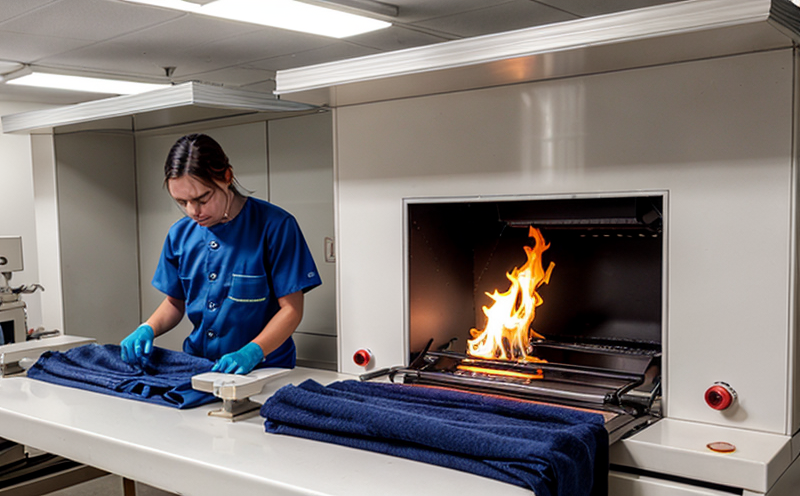Fire Resistance Testing of Nylon Fabrics
The fire resistance testing of nylon fabrics is a critical process to ensure that textiles and apparel meet safety standards in various industries, including aerospace, automotive, and healthcare. The primary objective of this test is to evaluate how well a nylon fabric withstands exposure to high temperatures or flames without igniting readily or sustaining significant damage.
Nylon, being one of the most versatile synthetic fibers known for its strength, flexibility, and durability, is widely used in various applications such as clothing, carpets, seat belts, and electrical insulation. However, when exposed to fire hazards, it must perform reliably under extreme conditions. This testing ensures that the fabric maintains its integrity and provides adequate protection against potential ignition sources.
The test typically follows recognized standards like ASTM D6413-18 or ISO 17592-2:2019, which outline specific procedures for conducting flame resistance tests on textiles. These standards provide detailed guidelines regarding specimen preparation, testing apparatus, and evaluation methods to ensure consistent results across different laboratories.
During the test, specimens of the nylon fabric are subjected to controlled burn conditions under specified parameters such as temperature, duration, and intensity of heat application. The outcome measures factors like flame spread rate, after-flame time, and char length – all crucial indicators for assessing fire resistance performance.
Understanding these testing protocols helps stakeholders like quality managers, compliance officers, R&D engineers, and procurement professionals make informed decisions about fabric selection based on safety requirements. By adhering to strict regulatory guidelines, manufacturers can produce safer products that comply with international standards while also enhancing consumer confidence through transparent product labeling practices.
Industry Applications
| Application Sector | Key Industry Applications |
|---|---|
| Aerospace | Development of flame-resistant seat covers and cabin lining materials. |
| Automotive | Manufacturing of fire-retardant upholstery for vehicles. |
| Healthcare | Production of burn dressings that can withstand prolonged exposure to flames without igniting or melting. |
- In the aerospace industry, flame resistance testing ensures passenger safety by preventing rapid spread of fire in case of emergencies.
- The automotive sector benefits from flame retardant upholstery which minimizes risk during accidental fires inside vehicles.
- Healthcare facilities use specially designed dressings that are stable under extreme heat conditions to treat burn injuries effectively.
These applications highlight the importance of rigorous fire resistance testing in ensuring safety across multiple sectors where textiles come into contact with potential ignition sources. Compliance with relevant standards not only protects consumers but also fosters trust within regulatory bodies and the general public.
Why Choose This Test
Selecting fire resistance testing for nylon fabrics is essential because it directly impacts safety outcomes in high-risk environments. For instance, in aerospace applications, even small fires can have catastrophic consequences due to confined spaces and oxygen-rich atmospheres. Similarly, automotive interiors must meet stringent flammability limits imposed by regulatory bodies worldwide.
By subjecting nylon fabrics to controlled burn tests, manufacturers gain valuable insights into their material properties under simulated fire scenarios. This information enables them to optimize formulas, improve processing techniques, or select alternative materials if necessary. Additionally, successful completion of these tests can contribute significantly towards gaining certifications from authoritative organizations such as the FAA (Federal Aviation Administration), SAE International, or other relevant bodies.
The results obtained from fire resistance testing also play a crucial role in marketing strategies by highlighting product safety features to potential customers. Transparent communication about meeting industry standards enhances brand reputation and builds long-term relationships with end-users who prioritize their personal safety above all else.
Quality and Reliability Assurance
Ensuring the highest levels of quality and reliability in fire resistance testing requires adherence to strict protocols and state-of-the-art equipment. Our laboratory employs experienced technicians trained in operating advanced flame testers capable of replicating real-world fire conditions accurately.
We follow internationally recognized standards such as ASTM D6413-18 and ISO 17592-2:2019, ensuring consistency and comparability with other laboratories globally. Each specimen undergoes thorough preparation before being subjected to rigorous testing procedures designed to simulate actual fire exposure scenarios.
The detailed reports generated after each test provide comprehensive data on the performance metrics of the nylon fabric under scrutiny. These reports are invaluable tools for manufacturers seeking to improve product design or demonstrate compliance with regulatory requirements confidently.





